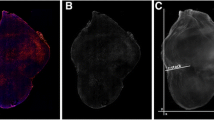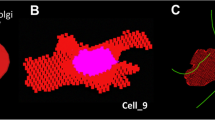Abstract
Purpose
The spatial distribution of radiopharmaceuticals within multicellular clusters is known to have a significant effect on their biological response. Most therapeutic radiopharmaceuticals distribute nonuniformly in tissues which makes predicting responses of micrometastases challenging. The work presented here analyzes published temporally dependent nonuniform activity distributions within tumor spheroids treated with actinium-225-DOTA encapsulating liposomes (225Ac-liposomes) and uses these data in MIRDcell V3.11 to calculate absorbed dose distributions and predict biological response. The predicted responses are compared with experimental responses.
Methods
Four types of liposomes were prepared having membranes with different combinations of release (R) and adhesion (A) properties. The combinations were R−A−, R−A+, R+A−, and R+A+. These afford different penetrating properties into tissue. The liposomes were loaded with either carboxyfluorescein diacetate succinimidyl ester (CFDA-SE) or 225Ac. MDA-MB-231 spheroids were treated with the CFDA-SE-liposomes, harvested at different times, and the time-integrated CFDA-SE concentration at each radial position within the spheroid was determined. This was translated into mean 225Ac decays/cell versus radial position, uploaded to MIRDcell, and the surviving fraction of cells in spherical multicellular clusters was simulated. The MIRDcell-predicted surviving fractions were compared with experimental fractional-outgrowths of the spheroids following treatment with 225Ac-liposomes.
Results
The biological responses of the multicellular clusters treated with 225Ac-liposomes with physicochemical properties R+A+, R−A+, and R−A− were predicted by MIRDcell with statistically significant accuracy. The prediction for R+A− was not predicted accurately.
Conclusion
In most instances, MIRDcell predicts responses of spheroids treated with 225Ac-liposomes that result in different tissue-penetrating profiles of the delivered radionuclides.







Similar content being viewed by others
References
Howell RW. The MIRD schema: from organ to cellular dimensions. J Nucl Med. 1994;35:531–3.
Loevinger R, Budinger TF, Watson EE. MIRD primer for absorbed dose calculations. Revised. New York: The Society of Nuclear Medicine; 1991.
Howell RW, Wessels BW, Loevinger R, Watson EE, Bolch WE, Brill AB, et al. The MIRD perspective 1999. J Nucl Med. 1999;40:3S-10S.
Prasad A, Nair R, Bhatavdekar O, Howe A, Salerno D, Sempkowski M, et al. Transport-driven engineering of liposomes for delivery of alpha-particle radiotherapy to solid tumors: effect on inhibition of tumor progression and onset delay of spontaneous metastases. Eur J Nucl Med Mol Imaging. 2021. https://doi.org/10.1007/s00259-021-05406-z.
Stras S, Holleran T, Howe A, Sofou S. Interstitial release of cisplatin from triggerable liposomes enhances efficacy against triple negative breast cancer solid tumor analogues. Mol Pharm. 2016;13:3224–33. https://doi.org/10.1021/acs.molpharmaceut.6b00439.
Zhu C, Sempkowski M, Holleran T, Linz T, Bertalan T, Josefsson A, et al. Alpha-particle radiotherapy: for large solid tumors diffusion trumps targeting. Biomaterials. 2017;130:67–75. https://doi.org/10.1016/j.biomaterials.2017.03.035.
Sofou S. Radionuclide carriers for targeting of cancer. Int J Nanomed. 2008;3:181–99.
Howell RW, Rajon D, Bolch WE. Monte Carlo simulation of irradiation and killing in three-dimensional cell populations with lognormal cellular uptake of radioactivity. Int J Radiat Biol. 2012;88:115–22. https://doi.org/10.3109/09553002.2011.602379.
Neti PVSV, Howell RW. Biological response to nonuniform distributions of 210Po in multicellular clusters. Radiat Res. 2007;168:332–40.
Neti PV, Howell RW. Log normal distribution of cellular uptake of radioactivity: implications for biologic responses to radiopharmaceuticals. J Nucl Med. 2006;47:1049–58. 47/6/1049 [pii].
Neti PV, Howell RW. Lognormal distribution of cellular uptake of radioactivity: statistical analysis of alpha-particle track autoradiography. J Nucl Med. 2008;49:1009–16. https://doi.org/10.2967/jnumed.107.048843.
Minchinton AI, Tannock IF. Drug penetration in solid tumours. Nat Rev Cancer. 2006;6:583–92. https://doi.org/10.1038/nrc1893.
Vaziri B, Wu H, Dhawan AP, Du P, Howell RW. MIRD Pamphlet No. 25: MIRDcell V2.0 software tool for dosimetric analysis of biologic response of multicellular populations. J Nucl Med. 2014;55:1557–64. https://doi.org/10.2967/jnumed.113.131037.
Howell RW, Wang J, Katugampola S. MIRDcell User Manual V3.11.01. 2022. https://mirdcell.njms.rutgers.edu/publications.php.
Katugampola S, Wang J, Howell RW. MIRD Pamphlet No. 27: MIRDcell V3, a revised software tool for multicellular dosimetry and bioeffect modeling. J Nucl Med. 2022. https://doi.org/10.2967/jnumed.121.263253.
Chang MY, Seideman J, Sofou S. Enhanced loading efficiency and retention of 225Ac in rigid liposomes for potential targeted therapy of micrometastases. Bioconjug Chem. 2008;19:1274–82. https://doi.org/10.1021/bc700440a.
Stras S, Howe A, Prasad A, Salerno D, Bhatavdekar O, Sofou S. Growth of metastatic triple-negative breast cancer is inhibited by deep tumor-penetrating and slow tumor-clearing chemotherapy: the case of tumor-adhering liposomes with interstitial drug release. Mol Pharm. 2020;17:118–31. https://doi.org/10.1021/acs.molpharmaceut.9b00812.
Akudugu JM, Azzam EI, Howell RW. Induction of lethal bystander effects in human breast cancer cell cultures by DNA-incorporated iodine-125 depends on phenotype. Int J Radiat Biol. 2012;88:1028–38. https://doi.org/10.3109/09553002.2012.683511.
Neti PV, Howell RW. Isolating effects of microscopic nonuniform distributions of 131I on labeled and unlabeled cells. J Nucl Med. 2004;45:1050–8.
Goddu SM, Rao DV, Howell RW. Multicellular dosimetry for micrometastases: dependence of self-dose versus cross-dose to cell nuclei on type and energy of radiation and subcellular distribution of radionuclides. J Nucl Med. 1994;35:521–30.
O’Donoghue JA, Bardies M, Wheldon TE. Relationships between tumor size and curability for uniformly targeted therapy with beta-emitting radionuclides. J Nucl Med. 1995;36:1902–9.
Howell RW, Rao DV, Sastry KSR. Macroscopic dosimetry for radioimmunotherapy: nonuniform activity distributions in solid tumors. Med Phys. 1989;16:66–74.
Solanki JH, Tritt T, Pasternack JB, Kim JJ, Leung CN, Domogauer JD, et al. Cellular response to exponentially Increasing and decreasing dose rates: Implications for treatment planning in targeted radionuclide therapy. Radiat Res. 2017;188:221–34. https://doi.org/10.1667/RR14766.1.
Leung CN, Canter BS, Rajon D, Back TA, Fritton JC, Azzam EI, et al. Dose-dependent growth delay of breast cancer xenografts in the bone marrow of mice treated with radium-223: the role of bystander effects and their potential for therapy. J Nucl Med. 2020;61:89–95. https://doi.org/10.2967/jnumed.119.227835.
Canter BS, Leung CN, Fritton JC, Back T, Rajon D, Azzam EI, et al. Radium-223-induced bystander effects cause DNA damage and apoptosis in disseminated tumor cells in bone marrow. Mol Cancer Res. 2021;19:1739–50. https://doi.org/10.1158/1541-7786.MCR-21-0005.
Howell RW, Narra VR, Rao DV. Absorbed dose calculations for rapidly growing tumors. J Nucl Med. 1992;33:277–81.
Goddu SM, Howell RW, Rao DV. A generalized approach to absorbed dose calculations for dynamic tumor and organ masses. J Nucl Med. 1995;36:1923–7.
Malaroda A, Flux GD, Buffa FM, Ott RJ. Multicellular dosimetry in voxel geometry for targeted radionuclide therapy. Cancer Biother Radiopharm. 2003;18:451–61.
Rajon DA, Canter BS, Leung CN, Back TA, Fritton JC, Azzam EI, et al. Modeling bystander effects that cause growth delay of breast cancer xenografts in bone marrow of mice treated with radium-223. Int J Radiat Biol. 2021;97:1217–28. https://doi.org/10.1080/09553002.2021.1951392.
Charlton DE. Radiation effects in spheroids of cells exposed to alpha emitters. Int J Radiat Biol. 2000;76:1555–64.
Roeske JC, Stinchcomb TG. The average number of alpha-particle hits to the cell nucleus required to eradicate a tumour cell population. Phys Med Biol. 2006;51:N179–86. https://doi.org/10.1088/0031-9155/51/9/N02.
Funding
This study was supported in part by grant 1R01CA245139 from NCI.
Author information
Authors and Affiliations
Contributions
SK analyzed data and drafted the manuscript. JW programmed MIRDcell V3.11 to facilitate the analysis. AP provided experimental data. SS conceived the liposome experiments, led the Hopkins team, and edited the manuscript. RWH conceived the collaborative project, led the Rutgers team, and edited the manuscript.
Corresponding author
Ethics declarations
Ethical approval
This article does not contain any studies with human participants or animals performed by any of the authors.
Conflict of interest
Sumudu Katugampola (SK), Jianchao Wang (JW), and Roger W. Howell (RWH) declare they have financial interests. RWH holds patent US 9,623,262 patent for MIRDcell V2. SK, JW, and RWH have petitioned Rutgers University to apply for a patent for MIRDcell V3.
Additional information
Publisher's note
Springer Nature remains neutral with regard to jurisdictional claims in published maps and institutional affiliations.
This article is part of the Topical Collection on Radiation biology.
Supplementary Information
Below is the link to the electronic supplementary material.
Rights and permissions
About this article
Cite this article
Katugampola, S., Wang, J., Prasad, A. et al. Predicting response of micrometastases with MIRDcell V3: proof of principle with 225Ac-DOTA encapsulating liposomes that produce different activity distributions in tumor spheroids. Eur J Nucl Med Mol Imaging 49, 3989–3999 (2022). https://doi.org/10.1007/s00259-022-05878-7
Received:
Accepted:
Published:
Issue Date:
DOI: https://doi.org/10.1007/s00259-022-05878-7




